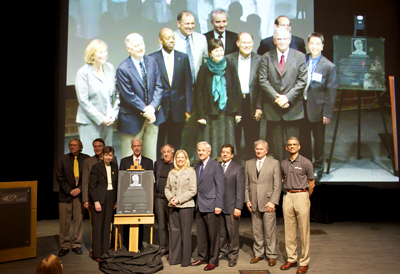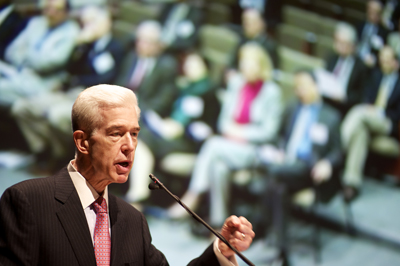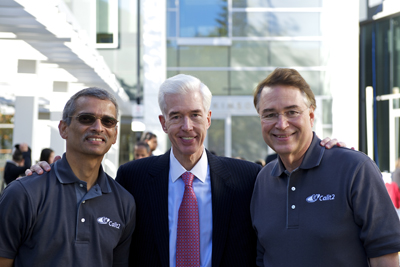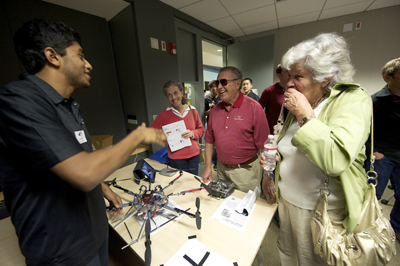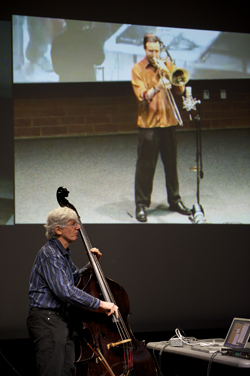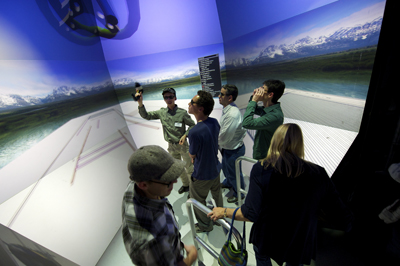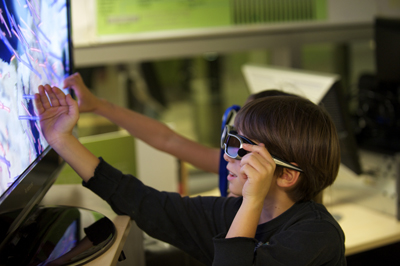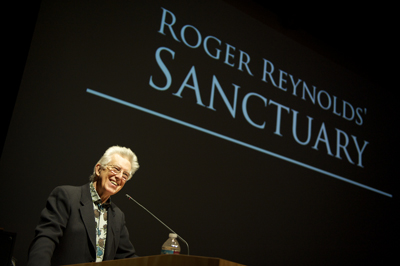Celebrating a Decade of Cross-Disciplinary Innovation in Calit2
San Diego, December 13, 2010 -- In the span of a single decade, the California Institute for Telecommunications and Information Technology (Calit2) has emerged as one of the world’s most advanced testbeds for scientific visualization, virtual/physical collaboration and ‘green’ computing. It has forged partnerships with industrial and institutional powerhouses, including Qualcomm and National Geographic, Ericsson, Conexant and over 200 other industry partners. And it has done it by leveraging the $100 million in original funding from the State of California into $715 million in support Calit2 raised from federal, industry, foundation and international institutions in the past 10 years.
|
Gov. Davis played a pivotal role in securing support and funding for Calit2 and the three other institutes that make up what are now called the Governor Gray Davis Institutes for Science and Innovation. To the Joint Plenary Ceremony that linked the UC San Diego division of Calit2 with its sister division at UC Irvine via real-time HD videoconferencing, Davis emphasized the role that research universities and their affiliated institutes play in stimulating the California economy.
“Research universities are not only the place where your children and grandchildren are educated -- these universities create whole new economies,” he told those assembled. “If you want to fund your economy, you help fund research universities. You cannot outsource an idea until it’s invented.”
|
“People all around the world are investing in these institutes, which means they’ll probably be around for decades,” he said. “I’m convinced the people in this audience will change the world. The best, I know, is yet to come.”
The two-hour opening ceremony was co-hosted by the Chancellors of Calit2’s two participating campuses – Marye Anne Fox at UCSD, and Michael Drake at UC Irvine – and they introduced a procession of academic, government and industry leaders who played roles in Calit2’s creation and success. When the institutes were created in December 2000, Richard C. Atkinson was President of the University of California, and Robert C. Dynes was Chancellor of UCSD.
“Calit2 has shown how it can become an institute of the world, how it can demonstrate how to address serious global problems to the benefit of the world and to the benefit of our home – to San Diego, to California,” said Dynes. “We’re attracting the best people in the world, so I am excitedly looking forward to the next 10 years.”
|
“We had two revolutions that took place in the Nineties, not one: the first was the birth of the World Wide Web and the explosion of the Internet, and independently – independently – there was the wireless mobility revolution,” said Conn in a video message. “There was nothing comparable to those two revolutions of the 1990s, so picking telecom and IT was picking the two revolutions.”
“Governor Davis should feel really proud that the institute has worked,” added Conn. “It has produced innovation, it has drawn resources to California that would not otherwise have come, and it has been a remarkable thing for this entire region.”
Conn's successor as Dean of the Jacobs School and Chair of Calit2's Governing Board, Frieder Seible, was in China during the event, but sent a message of his own. “Calit2 has pioneered a successful paradigm for multi-disciplinary research, enabled by open, shared laboratories, and world-class core facilities led by talented professional researchers," observed Seible. "From its inception, Calit2 has been an integral part of the Jacobs School, providing the infrastructure and culture that encourages our faculty and students to collaborate across traditional disciplines and with the wider international research community.”
Today Conn, Atkinson and Dynes all have their UCSD offices in Atkinson Hall, Calit2’s headquarters building at UCSD which was named in honor of the former UC President. In honoring Davis, Atkinson pointed out that the then-Governor bucked political opposition to investing so heavily in a “Bell Labs” on UC campuses:
“Gray Davis was an enthusiastic supporter of the proposal,” recalled Atkinson. “When it was finished, we had four proposals to spend $400 million right off the top. Some in the legislature wanted to fund them over time, but Gray insisted on the full amount from the start.”
|
“I think, in fact, it has turned out much better than we had anticipated,” said Jacobs, who was in Hong Kong for Qualcomm’s first-ever Board of Directors meeting in Asia. “Having something like Calit2 -- an institution that is devoted to bringing together many different ideas and looking for topics that then allow some growth in different directions -- I think that’s all very important.
“Qualcomm has grown quite a bit and become interested in a wide variety of areas, as has Calit2,” he continued, adding that both institutions have become interested in “not just communication and computing aspects, but a wide variety of applications from education to medicine to cultural activities.”
One of the UC Irvine division’s chief benefactors, Broadcom founder Henry Samueli, also pre-recorded his remarks.
Among the San Diego business leaders attending the ceremony was Duane Roth, president of CONNECT. "Calit2 has been a remarkable experiment that worked," said Roth. "As a board member since Calit2 began, I don't think any of us could have imagined 10 years ago that the institute would have such a far-reaching impact on the innovation economy in San Diego."
Calit2’s “path forward” -- and its four research themes pertaining to energy, environment, health and culture -- was the subject of remarks delivered by Calit2 Director Larry Smarr. He noted that in order for Calit2 to make significant progress in these areas, the institte needs to harness the collective brain power of “the best minds in the world.”
“We can’t be parochial,” Smarr added. “There are amazing challenges on a scale humanity hasn’t faced before, so it can’t be business as usual. We don’t have the time.”
|
The morning ceremony then ended on a high note – literally – when music professors Mark Dresser of UCSD and Michael Dessen of UCI performed a “telematic” concert via Calit2’s videoconferencing technology. The performance underscored the role that Calit2 can play in developing new technologies for long-distance collaboration, and the benefit that those technologies can deliver in a carbon-constrained world.
After an invitation-only luncheon, the UCSD division opened its doors to the wider campus and public communities. A packed agenda included two separate symposia featuring a total of 28 speakers, a laboratory open house, technology demos, musical performances and a late-night showcase for UCSD videos shot in the highest-resolution picture quality for use in digital cinema.
The afternoon’s four-hour symposium in the Calit2 Auditorium at UC San Diego included talks by distinguished UCSD faculty members who are affiliated with the institute. Among them: social networking expert and political science professor James Fowler (in a lecture titled “Back to the Village”); neuroscientist Maryann Martone (“Establishing a Global Neuroscience Information Framework”); digital archaeologist and anthropology professor Thomas Levy (“Cyber-Archaeology Solutions to the Data Avalanche and World Cultural Heritage”); and visual artist Lev Manovich (“Analyzing Patterns in Media Content with Supercomputers and Supervisualization”). [To watch presentations in the Auditorium or the Calit2 Theater, click here.]
|
Speakers included assistant professor of cognitive science Ayse Saygin, who uses magnetic resonance imaging (fMRI) to peer into the brains of test subjects as they interact with on-screen avatars. Saygin’s research -- which she summarized in a talk titled “Body Movements: From Dots to Robots” -- aims to provide a scientific basis for the “uncanny valley,”a phenomenon in robotics, computer graphics and animation.
Another speaker was CSRO Fellow and electrical and computer engineering Ph.D. student Ramsin Khoshabeh, who discussed his efforts to create a 3D-enabled surgical system in the form of autostereoscopic displays that enable surgeons and their teams to see a 3D video feed from stereo surgical cameras without the need for any special glasses.
Visitors to Calit2 were also invited to tour Atkinson Hall’s six floors of laboratory space, where research teams work in fields as disparate as nanotechnology and disaster response. Calit2’s super-high-resolution HIPerSpace tiled display wall was the setting for a number of demos pertaining to research conducted at Calit2’s Center of Interdisciplinary Science for Art, Architecture and Archaeology (CISA3), as well as its Software Studies Initiative and the High Performance Wireless Research and Education Network (HPWREN). For the latter, a series of networked webcams help local firefighters and emergency agencies spot back-country wildfires much sooner than they could ordinarily.
A Lego-equipped “Kids’Zone” for budding scientists and engineers was set up on the 5th floor by Calit2 MyLab director Saura Naderi, and many in attendance also gravitated toward the 3D displays in the first-floor Virtulab and StarCAVE, where visitors could “walk through” a magnified three-dimensional model of a human protein.
|
“Before the event, I had no idea that it could be so effective in presenting research data and information,” he said. “The 3D modeling really brought information to life. It was just amazing.”
Following a brief evening reception, Calit2’s guests were treated to a performance in the Calit2 Auditorium by the institute’s newly appointed composer-in-residence and UCSD Music Department faculty member Rand Steiger, who introduced his “Nested Etudes for Oboe”, featuring oboist Karisa Werdon. Steiger also demonstrated some of the signal processing techniques he has developed for creating a variety of sounds from a given instrument and signed 25 copies of his new CD and multichannel DVD set, “ECOSPHERE: Music for Instruments and Electronics.”
Former Calit2 composer-in-residence Roger Reynolds then took to the stage with introductory remarks followed by the world premiere screening of the a studio HD recording of his composition, “Sanctuary,” which was produced by Ross Karre with funding from Calit2 and shot entirely in Atkinson Hall. The 75-minute video was presented as an Integrated Perspectives Recording (IPer), a new concept for capturing the choreographic exchange of gestures and positions that are an integral part of Reynolds’ work. The performance, which is scored for percussion with real-time computer sound processing and spatialization, features the UCSD percussion ensemble w, UCSD Distinguished Professor Steven Schick, and computer musician Ian Saxton, assisted by Jacob Sudol.
|
The Digital Cinema Showcase featured the premiere of “Calit2 4K,” the first video about the institute to be shot entirely in the 4K format. The video features interviews with Calit2 director Larry Smarr and UCSD division director Ramesh Rao and includes sequences captured in various Atkinson Hall labs. Other videos at the Showcase included Calit2 Artist-in-Residence Sheldon Brown’s “Scalable City”; Visual Arts Associate Professor Cauleen Smith’s digital cinema piece, “Remote Viewing”, which re-enacts the destruction of a one-room schoolhouse in the 1970s.
Among those in attendance at the Showcase was Ebonee Williams, who works for the Jacobs School of Engineering’s Bernard and Sophia Gordon Engineering Leadership Center. She was particularly taken with Smith’s cinematic contribution, but like many visitors to Calit2 for its 10th anniversary, Williams has watched the institute grow from the seedling of an idea to the full-fledged research powerhouse that it is today.
“As someone who was there when Atkinson Hall opened to the public," said Williams, "it was fun to see where Calit2 has taken all that great technology.”
Media Contacts
Tiffany Fox, tfox@ucsd.edu
Related Links
Calit2 10th Anniversary Website
Research Open House Presentation Videos
10th Anniversary Flickr Photostream


